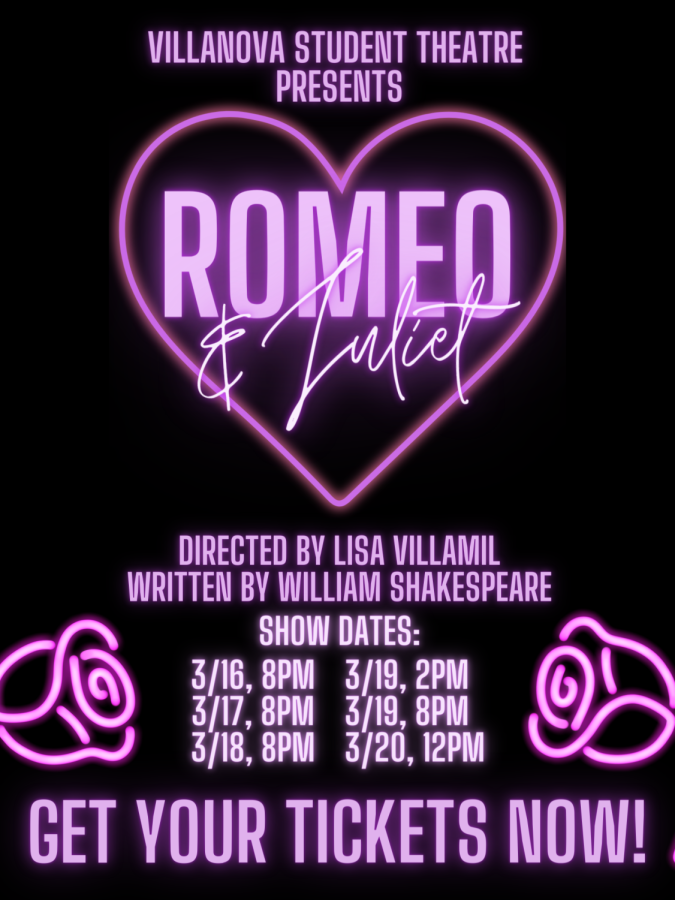Villanova Student Theatre’s Romeo and Juliet Preview
VST is showing Romeo and Juliet this March.
March 16, 2022
As the stage lights strike on, the only thing in view is a massive toy box in the center. Friar Lawrence, played by Ava Studivant, slams the top of the toy box shut, vaults over it and lands loudly, feet squared. She then begins the infamous introduction of the town of fair Verona, home to star-crossed lovers bound by obsessive adoration and familial chaos. While this does not sound like any “Romeo and Juliet” adaptation you have ever seen (the closest probably being the infamous version featuring Leonardo DiCaprio in a tropical shirt), rest assured Professional Director Lisa Villamil’s version stays true to the core values and details of the timeless story written by William Shakespeare so many years ago.
Villanova Student Theatre’s Spring production of “Romeo and Juliet” is unlike any other, taking on the challenge of integrating this ageless tale into the 90s party scene aesthetic. Villamil puts forward a passionate and energetic vision, revitalizing the tale for a 21st century audience. She does this in a way that preserves the agony of young heartache and familial chaos while currying a sense of incredulous joy, as the audience watches these beloved characters navigate love in modern clothing, wild parties and the iconic 90s grunge aesthetic. Juliet, played by Kylie Horan, is a vision in silk slip dresses, first in angelic white changing to a soft and loving pink after spotting her dear Romeo for the first time, played by Dominic Wierzbicki, in baggy jeans, converse, a blue crew and smudged eyeliner. The sensational meet-cute of the doomed lovers is revamped from a masquerade ball with figures dressed in their finest attire to a rave with loud rock music, glow-sticks and slated sunglasses obscuring dear Romeo’s true identity.
Still, this version of “Romeo and Juliet,” while new in many ways, stays true to many of the aspects English teachers had mulled over aloud in high school classes as we counted the minutes until lunch. But here, viewers are not counting the minutes, but falling off their seats, on the edge of which they sit. Audience members watch tensions bloom into chaos between the houses of Capulet and Montague, represented in sword duels and blood spilled in search of a bottom to the well of revenge that does not ever run dry. They watch two lovestruck teenagers run into each other’s arms with reckless abandon, and audience members are also struck, not with love, but clarity, as we watch them fight for love for the sake of love and its addictive glamor, obscuring the glaring reality of their dilemma. Whether viewers have experienced first love or not, they are dumbfounded as to how this play makes them feel this kind of obsession and grief as though it were their own.
The purpose of Shakespearean work has been and always will be performance and connection through performance. With new iterations of his work coming alive again and again, communities also come alive to celebrate these commonly known texts, and people are reminded of the magnitude of such experiences as these, and the relatability of the themes Shakespeare communicated so long ago. This version of “Romeo and Juliet” is enthralling and exciting, an eager addition to the many versions that change the way people think of the classics and how they come to understand, as Shakespeare wrote: “These violent delights have violent ends.”
If interested in seeing updates and behind-the-scenes from the production team, follow @romeoandjuliet.villanova and @vstheatre on Instagram. The tickets are on sale now, and the shows will run from March 16 through March 20.


